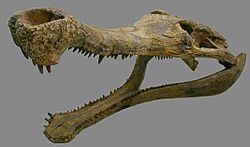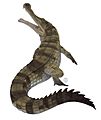Sarcosuchus facts for kids
Quick facts for kids SarcosuchusTemporal range: Lower Cretaceous
|
|
|---|---|
 |
|
| Sarcosuchus imperator skull | |
| Scientific classification | |
| Kingdom: | |
| Phylum: | |
| Class: | |
| Subclass: | |
| Infraclass: | |
| (unranked): | |
| Family: |
†Pholidosauridae
|
| Genus: |
†Sarcosuchus
Broin & Taquet, 1966
|
| Species | |
Sarcosuchus was a huge, extinct reptile that looked a lot like a modern crocodile. It lived a very long time ago, about 135 to 112 million years ago. This was during the Lower Cretaceous period. You would have found it in what is now Africa.
Even though it looked like a crocodile, Sarcosuchus was actually a "pre-crocodile." Scientists call these older types crocodylomorphs. The true crocodiles we know today appeared later, in the Upper Cretaceous period.
Sarcosuchus was one of the biggest crocodile-like reptiles ever. It was almost twice as long as a modern saltwater crocodile. It weighed around 8 tonnes, which is like the weight of a small truck!
For a long time, scientists only had a few fossil teeth and armour plates (called scutes) of Sarcosuchus. These were found in the Sahara Desert in the 1940s or 1950s.
Then, in 1997 and 2000, a scientist named Paul Sereno found many new fossils. One of these was almost half a complete skeleton, including most of its spine. Other giant crocodile fossils are usually just parts of skulls. This makes it hard to know which ancient crocodile was truly the biggest.
What Sarcosuchus Ate
Unlike some other huge ancient crocodiles, Sarcosuchus probably lived and hunted in rivers. Its strong jaws and teeth were good for grabbing and crushing. Some scientists think it hunted large animals and even smaller dinosaurs. It might have ambushed them, dragged them into the water, and then drowned them before tearing them apart.
However, the snout of Sarcosuchus was long and thin. This is very similar to modern crocodiles like the gharial. Gharials mostly eat fish and can't really hunt large prey. In contrast, modern Nile crocodiles and the extinct Deinosuchus have wide, heavy skulls. These are perfect for catching big animals.
Because of its snout shape and the many large fish found in its environment, many scientists now think Sarcosuchus was mainly a fish-eater. It might have been like a super-sized gharial.
Where Sarcosuchus Lived
About 110 million years ago, during the early Cretaceous, the Sahara was not a desert. It was a large tropical plain with many lakes and rivers. These rivers and streams had lots of plants growing along their banks.
Scientists have found many Sarcosuchus fossils. This suggests that these aquatic reptiles were common in these warm, shallow, freshwater places.
Today, modern crocodiles are quite similar in size and shape. They usually live in different areas. But in the time of Sarcosuchus, many different types of crocodyliforms lived in the same area. Scientists found four other kinds of extinct crocodyliforms in the same rock layers as Sarcosuchus. One was a tiny dwarf crocodile with a skull only 8 cm (3 in) long! These different ancient crocodiles filled various ecological roles. This meant they didn't compete with each other for food and space.
Images for kids
-
A reconstructed skeleton of S. imperator at the Indianapolis Children's Museum
See also
 In Spanish: SuperCroc para niños
In Spanish: SuperCroc para niños







